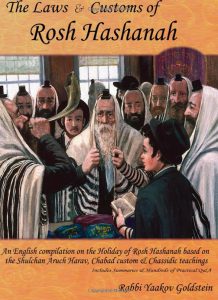
This article is an excerpt from our Sefer
Buy me here or on Amazon.com
1. Introduction:
A. The background of the Shofar blowing during Musaf: [1]
When Davening the Musaf prayer with a congregation, the Sages instituted to blow a set of blows during the blessing of Malchiyos, a set of blows during the blessing of Zichronos and a set of blows during the blessing of Shofros.[2] This institution of the Sages did not obligate a congregation to blow the Shofar on two different occasions, before and after Musaf, but rather merely that they should fulfill their Biblical obligation of Shofar blowing during the recital of the unique blessings that were established within the Musaf prayer.[3] Nevertheless the custom of all Jewry became to blow two sets of blows, before Musaf and during Musaf; before Musaf in order to fulfill the Biblical obligation and during Musaf in order to fulfill the institution of the Sages. What remains to be understood is as follows: How did the two occasions of Shofar blowing of before and during Musaf evolve? What was the reason that Jewry decided to blow also before Musaf if they could fulfill both their Biblical and Rabbinical obligation within Musaf? This was due to a desire to confuse the heavenly prosecutor prior to the Musaf prayer in order so he does not prosecute during the Musaf prayer, as [fulfilling the Mitzvah of] blowing the Shofar enters the Satan into a state of confusion and distress.[4] Thus in order so the blowing within Musaf does not interfere with the desire to confuse the Satan prior to Musaf the custom evolved to establish two occasions of blowing Shofar. The first time being after Kerias Hatorah, prior to Musaf in order to fulfill the Biblical obligation and hence confuse the Satan, and the second time during Musaf in order to fulfill the Rabbinical institution. In conclusion, as a result of this custom, the blowing that occurs today during Musaf is purely a Rabbinical blowing, as Biblically the command was fulfilled with the blowing before Musaf.[5]
B. The terms Tekios Meumad and Tekios Meyushav:[6]
The blows that are sounded during the Musaf prayer are referred to as the “Tekios Meumad/Standing Tekiahs” [תקיעות מעומד] being that [they are blown during the Chazan’s repetition of Shemoneh Esrei and hence] even the listeners must stand upon hearing them.[7] However the blows that are sounded prior to Musaf, after Kerias Hatorah, are referred to as the “Sitting Tekiahs” [תקיעות מיושב] being that it is permitted for the listeners to remain sitting during this time as only the person blowing must stand.[8]
[1] Based on Admur 592/7
[2] 592/1
Why did the Sages make this institution? The original custom was to blow the Shofar before Shacharis as Zerizin Makdimin Lemitzvos. However this was nullified due to a decree of the gentile monarchy. [Gemara R”H 32b] Hence they would blow the Shofar during Musaf as by that time the government agents were no longer there to witness the blowing. [Rashi ibid] Others however explain that the words of the Gemara “due to the gentile monarchy” means to say that it was dangerous to blow the Shofar before Shacharis as the gentiles thought that we blew the Shofar as a sign of waging war and they would hence attack. The sounds were thus changed to be blown during Musaf as the gentiles will simply think it is part of the regular prayers and not a vouch for war. [Tosafus 32b; Levush 585; Kaf Hachaim 585/5]
[3] Thus the Sages never instituted an additional blowing, but rather just the time for when one should blow.
[4] Admur ibid; R”H 16b; Tur brought in Kaf Hachaim 585/50; Rashi there “When the Satan sees how beloved the Mitzvos are to the Jewish people his claims against them are silenced”
[5] Vetzaruch Iyun as how can we uproot the decree of the Sages and decide to precede the Biblical Tekios to before Musaf simply to confuse the Satan? Seemingly the explanation of this is as follows: The Sages did not decree on the person that he must fulfill his Biblical obligation during Musaf and not beforehand. Rather they decreed on the Biblical Tekios, that from a Rabbinical perspective one only fulfills the Biblical Tekios when heard during Musaf. Thus in essence they created a Rabbinical form of Biblical Tekios. Thus when one decides to blow the Biblical Tekios before Musaf he has not uprooted any institution of the Sages, although he has not yet fulfilled the Rabbinical version of the Biblical Tekios which is to be heard during Musaf. This explanation answers a number of other queries: a) How are the two sets of blows considered one single Mitzvah as explained in 592/7? b) Why in 593/4 must we be taught that even if one does not know how to Daven Musaf he is still to blow the Shofar? Based on this it is understood as we might have thought the Sages said that one cannot fulfill the Mitzvah at any other time other than Musaf and hence if he can’t Daven Musaf there is no point of blowing Shofar. Thus in 593/4 we are taught that he is still to blow Shofar as the Sages merely created a Rabbinical form of Biblical Tekios and did not limit the fulfillment of the Biblical Mitzvah to a specific time.
Other Opinions: Some Poskim rule that the Biblical command of Shofar is not fulfilled before Musaf by Tekios Meyushav but rather during Musaf by Tekios Meumad. It is only blown before Musaf to confuse the Satan and not for the Mitzvah. [Radbaz 1/25; Mor Uketzia 585; Elya Raba 585/2; Mateh Yehuda; Machazik Bracha 585/1; Erech Hashulchan 585/1; Kaf Hachaim 585/2]
[6] 592/2
[7] See Halacha 4
[8] As explained in 585/1-2; See Chapter 2 Halacha 5



Leave A Comment?
You must be logged in to post a comment.